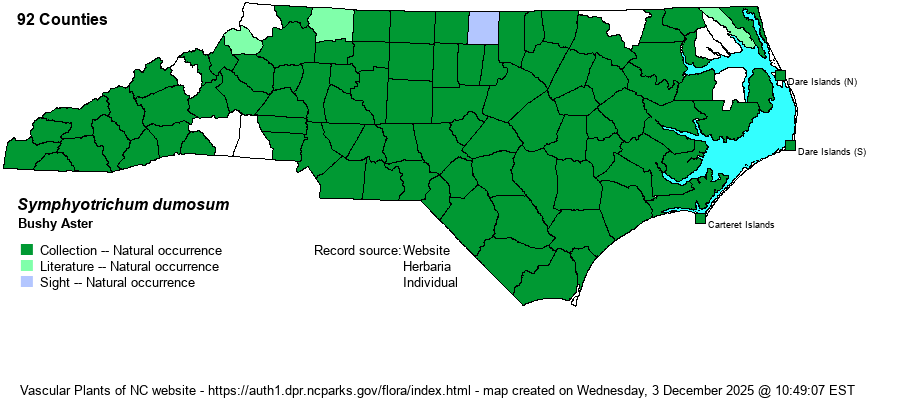| Author | (L.) Nesom | |
| Distribution | Throughout the state, undoubtedly found in every county. The map shown here will also stand for var. dumosum.
N.B. to southern Ont. and WI, south to FL and TX. | |
| Abundance | Common to abundant across nearly all of the Piedmont and Coastal Plain; much less numerous in the northern Coastal Plain and northern Mountains. Bushy Aster, along with Frost Aster (S. pilosum), are our most widespread asters. | |
| Habitat | Occurs in a wide variety of habitats, from dry to wet and open to moderately shaded. It is especially fond of open, perennially moist, ecotones of streams, marshes, roadside ditches, and adjacent drier fields, meadows, and pastures. The recognized varieties have much more restricted habitat types. |
| Phenology | Flowering and fruiting late August-October. | |
| Identification | Bushy Aster is one of several species with wide-spreading, branchy growth, seemingly hundreds of small and often narrow to linear leaves, and small heads with short pale blue to white rays -- indeed looking like a slender "bush". As a group they present a challenge to the field (and herbarium) botanist. We suggest that readers use Weakley's (2024) key or that of Fernald (1950). S. dumosum var. dumosum, which accounts for nearly all individuals in the state, is notable for its numerous and long branches in the inflorescence, which have lots of short, linear, and rather blunt bracts, in contrast to other species whose bracts are pointed or attenuate and thus more leaf-like. The other varieties of Bushy Aster have pointy bracts and are much less branched (or not at all) than var. dumosum. Note that some individuals of this species can have white ray flowers, as opposed to the more frequently encountered light blue; there are few other confusing species with light blue flowers, but a number of white-flowered species -- S. pilosum, S. lateriflorum, S. racemosum, and S. depauperatum -- among a few others, can cause identification troubles. | |
| Taxonomic Comments | NOTE: The genus Aster was examined by G.L. Nesom (1994), who determined that it was composed of a number of discrete genera (a few of which were already split off by authors as Sericocarpus, Ionactis, etc.). The earliest available name for North American "Aster" is Symphyotrichum, a name regrettably long and hard to spell.
FNA takes the extreme position and lumps all varieties, but notes that "some of these taxa may deserve higher rank." Following Weakley (2018), we recognize 4 varieties. This species needs a modern taxonomic overhaul.
| |
| Other Common Name(s) | Long-stalked Aster, Rice Button Aster | |
| State Rank | S5 | |
| Global Rank | G5 | |
| State Status | | |
| US Status | | |
| USACE-agcp | FAC link |
| USACE-emp | FAC link |

